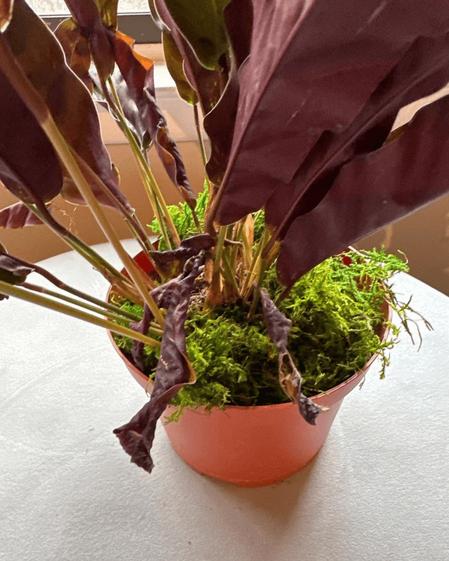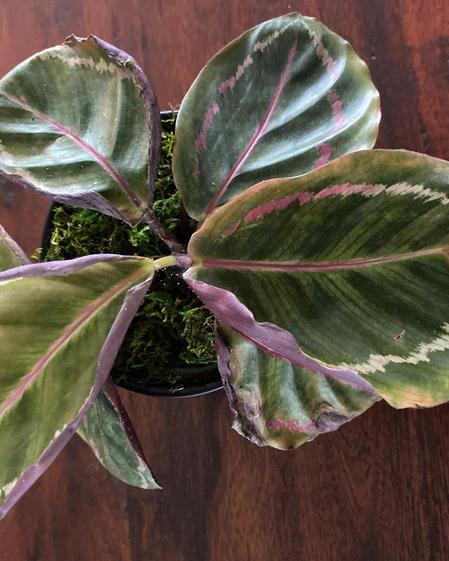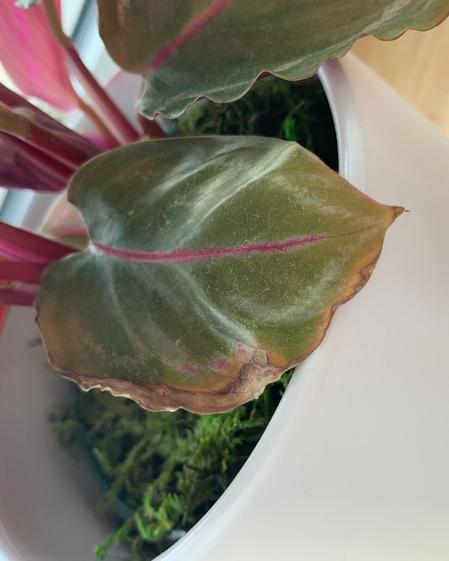Calathea Care Guide

With their vivid patterns, velvety textures, and dramatic foliage that moves with the light, Calatheas are truly living art. Beloved for their striking appearance and wide range of varieties, these tropical plants bring vibrant energy to any space. While they may be a bit particular about their care, with the right environment and a little attention, Calatheas like the Calathea Rattlesnake or Calathea Medallion can thrive and reward you with lush, ever-changing beauty. Read on for everything you need to know to care for your Calathea—whichever variety you have.
Simple Care Instructions for Calatheas
Light Requirements
Calatheas thrive in bright, indirect light and prefer filtered conditions that mimic the dappled light of their native tropical understory. Unlike many houseplants, they are sensitive to direct sunlight, which can cause their vibrant leaf patterns to fade and their delicate edges to crisp. To keep your Calathea healthy and colorful, avoid placing it in harsh or prolonged direct sun—especially during peak afternoon hours.
Watering Needs
Water thoroughly when the top inch of soil begins to feels dry, usually about once a week, though frequency may vary with the season and environment (very hot or dry conditions may mean watering twice or even three times a week).
Calatheas prefer consistently moist (but not soggy) soil and can be sensitive to both overwatering and underwatering. Bottom watering—letting the plant absorb water from the drainage holes—can help ensure even moisture and reduce the risk of root rot, especially for these humidity-loving plants.
Need some help with watering? Use a moisture meter to always know the best time to water. Shop our favorite minimalist moisture meter here.
Humidity and Temperature
Calatheas thrive in high humidity, making them perfect candidates for bathrooms, kitchens, or rooms with a humidifier. If your home tends to be dry, increase humidity by misting regularly, using a pebble tray, or placing a humidifier nearby—especially in the winter months.
These tropical plants prefer warm, stable temperatures between 65–80°F (18–27°C). Keep your Calathea away from cold drafts, heaters, and sudden temperature fluctuations, as they can be sensitive to stress. Unlike some hardier plants, Calatheas do not tolerate frost, so it’s important to protect them from chilly conditions.
Soil and Fertilizing
Use a well-draining, nutrient-rich potting mix to keep your Calathea healthy and thriving. A high-quality indoor plant mix with added perlite or orchid bark is ideal, as it improves aeration and prevents soggy roots.
To support healthy foliage and vibrant leaf patterns, feed your Calathea with a balanced liquid fertilizer every 2–4 weeks during the active growing season (spring and summer). Reduce or pause feeding in fall and winter, when the plant’s growth naturally slows.
Common Problems and Troubleshooting Tips
Curling Leaves
Symptoms: Leaves curl inward along the edges, sometimes appearing thin, dry, or slightly crispy.
Cause: Usually a response to low humidity and/or underwatering.
Solution: Calatheas are humidity-loving plants, and curling leaves are often their way of signaling stress. Try giving your plant a healthy soak ("bottom watering") and allow it to drink from the bottom up of its plastic nursery pot. In most cases, you will see the leaves magically unfurl by the next day. Moving forward, considering watering more frequently and/or with more quantity.
Leaf Browning
Symptoms: Brown tips or edges on the leaves, sometimes accompanied by crispness or a dry texture.
Cause: Often caused by low humidity, inconsistent watering, or a buildup of minerals from tap water.
Solution: Browning is a common issue for Calatheas and usually signals environmental stress. Boost humidity with a humidifier, misting, or a pebble tray. Ensure the plant is watered consistently—never letting it fully dry out or sit in soggy soil. If you’re using hard tap water, consider switching to filtered or distilled water, as Calatheas can be sensitive to chemicals and minerals. While browned edges won’t turn green again, new growth should emerge healthy with improved care.

Sometimes Calatheas will dry up older leaves to make energy for new ones.

Curling on Calatheas often indicates underwatering.

Brown edges might indicicate inconsistent watering or a mineral build up in the soil.
Seasonal Care Tips
Calatheas are sensitive to changes in temperature, humidity, and light, so seasonal adjustments are key to keeping them happy year-round. In summer, your plant may drink up to two to three times more water than it does the rest of the year!
Make minor adjustments throughout the season and be rewarded with your Calathea's uniquely colorful and patterned growth!
Thirsty for more? Check out our 10 Commandments of Calathea Care, a fun list of Calathea caretips to continue mastering the art of the beautifully colorful prayer plant.





